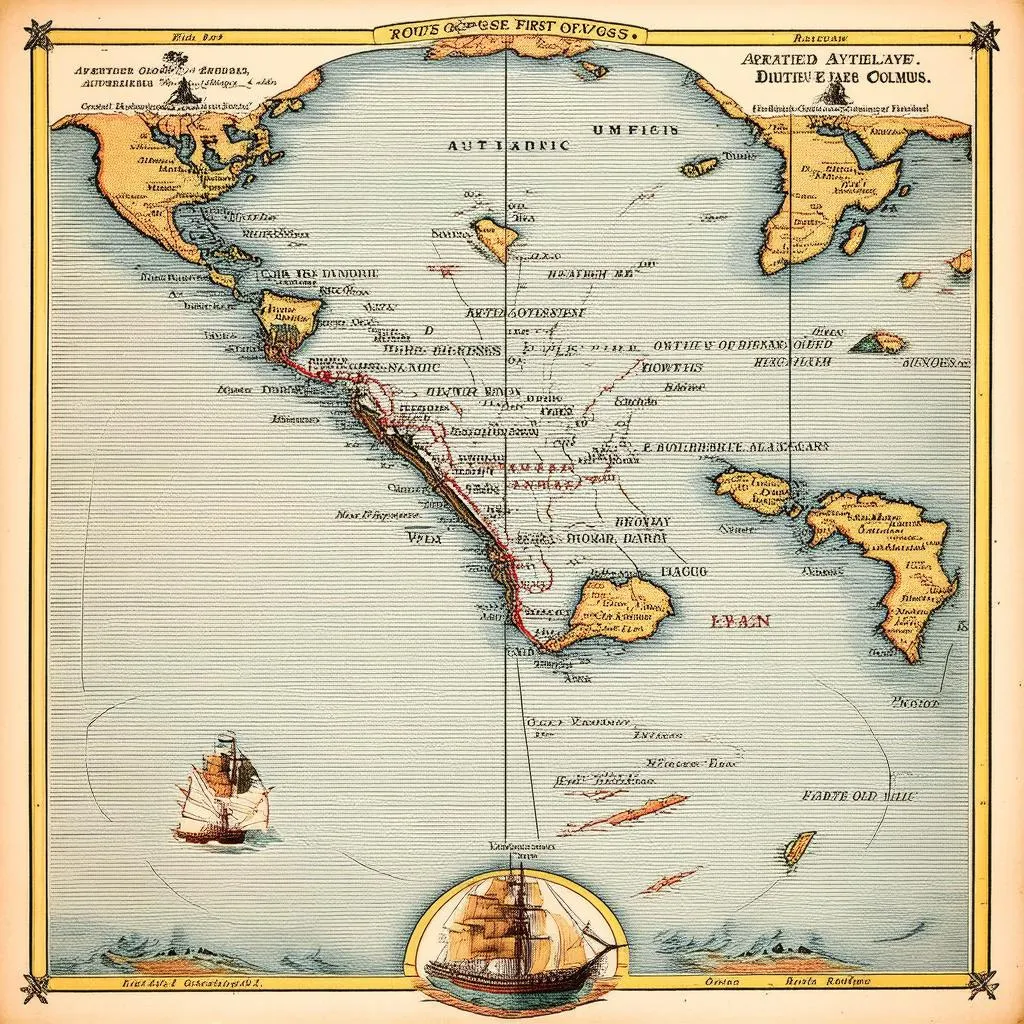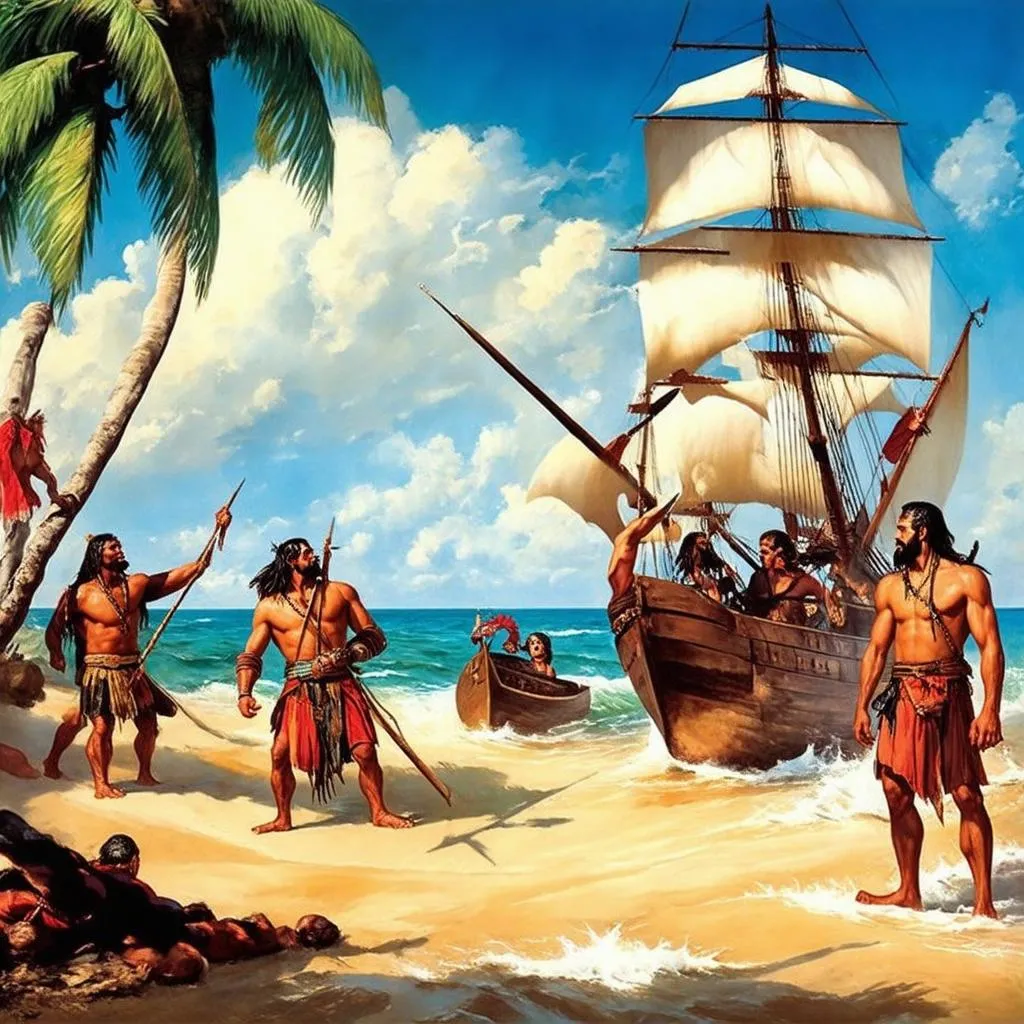“Exploration is the engine that drives human progress,” said renowned historian Dr. Emily Carter in her book “Voyages of Discovery.” And what better example of this than the daring journeys of Christopher Columbus? While his name echoes through history, many are surprised to learn where his explorations actually took him. Let’s embark on our own journey of discovery, tracing the paths of Columbus and uncovering the secrets of his voyages.
Charting the Course: A Look at Columbus’ Four Voyages
Columbus’ explorations weren’t just a single trip, but rather four distinct voyages that spanned over a decade. Each expedition had its own goals, challenges, and, of course, destinations.
Voyage 1: 1492-1493 – The First Footfall in the New World
Imagine the anticipation, the fear, and the excitement that must have filled the air as Columbus set sail from Palos de la Frontera, Spain in 1492. His goal? To find a westward route to Asia. However, instead of landing in India or China, Columbus encountered a “New World.”
- Land Ho! The Bahamas and Hispaniola: His first landfall was in the Bahamas, on an island he named San Salvador. He also explored Cuba and Hispaniola, establishing the first European settlement in the Americas on the latter.
- A New Reality: This voyage, while significant, was just the beginning. Columbus, convinced he had reached Asia, returned to Spain with tales of the indigenous people he called “Indians,” sparking further interest in exploration.
 Columbus' First Voyage
Columbus' First Voyage
Voyage 2: 1493-1496 – Expanding the Horizons
With the support of the Spanish crown, Columbus returned to the Caribbean, this time with a much larger fleet. This expedition was about more than just exploration; it marked the beginning of colonization.
- Island Hopping: This voyage took him to several new islands, including Dominica, Guadeloupe, Jamaica, and Puerto Rico. He also established the first Spanish colony in the Americas on Hispaniola, named La Isabela.
- Troubled Waters: While this voyage brought new discoveries, it also marked the beginning of conflict with the indigenous populations, setting a dark precedent for future interactions.
Voyage 3: 1498-1500 – Reaching the South American Mainland
Driven by a desire to find a strait to Asia, Columbus embarked on his third voyage. This time, his journey took him closer to the equator, bringing him to the South American mainland.
- A New Continent: He landed on the coast of what is now Venezuela, becoming the first European to set foot on the South American continent.
- Facing the Music: This voyage was fraught with difficulties, including illness and political turmoil back in Hispaniola. Columbus returned to Spain in chains, accused of mismanagement.
Voyage 4: 1502-1504 – A Final Attempt and a Legacy Forged
Though stripped of his governorship, Columbus was permitted one final voyage. He sailed along the coast of Central America, hoping to find a passage to the Indian Ocean.
- Central American Coast: This voyage took him to Honduras, Nicaragua, Costa Rica, and Panama. However, he never found the elusive westward passage to Asia.
- A Final Farewell: Columbus returned to Spain in 1504, his health failing. He died in 1506, still believing he had reached Asia.
Columbus’ Legacy: A Complex Tapestry of Exploration and Impact
 Columbus Landing on Hispaniola
Columbus Landing on Hispaniola
Columbus’ voyages weren’t just about geographical discoveries; they were pivotal in shaping the course of history. His journeys opened up the Americas to European exploration, colonization, and trade, forever changing the world map and the course of human history.
However, it’s crucial to acknowledge the darker side of this legacy. The arrival of Europeans had a devastating impact on the indigenous populations, leading to disease, displacement, and exploitation. While we marvel at the spirit of exploration, it’s essential to remember the human cost and learn from the past as we navigate the future of travel and cultural exchange.
Planning Your Own Voyage of Discovery?
Are you inspired by the voyages of Christopher Columbus and dreaming of your own adventures? Here at travelcar.edu.vn, we believe that exploration knows no bounds. Let us help you plan your next great adventure.
Before you set sail, consider these questions:
- Where do you want to explore? The world is full of fascinating destinations, each with its own unique history and culture.
- What kind of traveler are you? Are you seeking adventure, relaxation, or cultural immersion?
- What is your budget? Traveling can be expensive, so it’s important to plan accordingly.
No matter what your travel dreams may be, travelcar.edu.vn is here to help you make them a reality.
Contact us today to start planning your next journey!